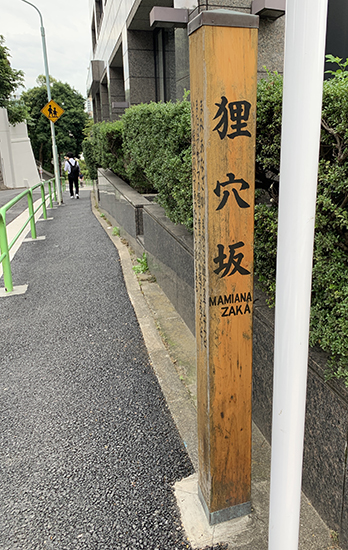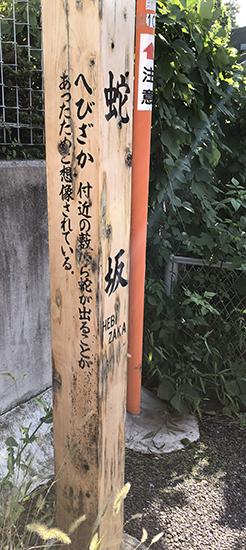The Animals Prowling Tokyo Streets
In the last blog post, I mentioned that Russell Hogg had developed a fun obsession with the signposts on some Tokyo slopes and that he had kindly shared his collection of signpost photos with me. Today we'll look at some with animal themes.
Several slope names emerged because certain animals frequented those parts. However, when you see an animal kanji in the name, you can't always assume that that's the inspiration. Take a wild guess: Which two of these three animals inspired the names we're about to examine:
a. 鳥 (bird)
b. 蛇 (snake)
c. 狸 (tanuki, a raccoon dog)
While you're thinking about it, I'll share a sneak preview of the newest essay:
The correct answers:
b. 蛇 (snake)
c. 狸 (tanuki, a raccoon-dog)
Let's take all the animals one species at a time.
The Lack of Birds on Toriizaka

I'm sure I've heard that a 鳥居 (とりい: torii) is so called because birds (鳥) like to sit (居) on those Shinto shrine archways. My proofreader checked his sources and found an etymology only in Nihon Kokugo Dai-Jiten. That source says that in the olden days, a torii may have served as a perch for chickens being offered to gods.
Whatever the specifics of the story, it's instinctive to think that 鳥居坂 (とりいざか) would be named that because birds congregate in the area. I mean, that's just obvious. It's also wrong!
After the name 鳥居坂 and the two pronunciation guides (TORIIZAKA and とりいざか, respectively), we see this text on the post:
江戸時代のなかばまで坂の東側に大名鳥居家の屋敷があった、元禄年間(一六八八–一七〇三)ごろ開かれた道である。
(The slope is called that because) until the middle of the Edo era, a feudal lord named Torii and his family had a house on the east side of the hill. The path was developed during the Genroku era (1688–1703).
江戸時代 (えどじだい: Edo era, 1603–1867); なかば (半ば: middle); 坂 (さか: slope); 東側 (ひがしがわ: east side); 大名 (だいみょう: daimyo, a feudal lord); 鳥居家 (とりいけ: Torii family); 屋敷 (やしき: residence); 元禄 (げんろく: Genroku (era), 1688–1703); 年間 (ねんかん: during an era); 一六八八 (せんろっぴゃくはちじゅうはち: 1688); 一七〇三 (せんななひゃくさん: 1703); ごろ (about); 開く (ひらく: to develop, shown here in the past tense of its passive voice); 道 (みち: path)
The Snakes of Hebizaka
I'm thankful that the snake post has little text because it gives me the heeby-jeebies to think about snakes (which makes hebi seem a most appropriate term for "snake"). Here are two views of the post in question:

After the pronunciation guides for 蛇坂 we find this:
付近の藪から蛇が出ることがあったためと想像されている。
The slope is thought to be called that because snakes used to emerge from bushes around this neighborhood.
付近 (ふきん: neighborhood); 藪 (やぶ: bush, a non-Joyo kanji); 蛇 (へび: snake); 出る (でる: to appear); 想像 (そうぞう: imagination, guess)
Tanukizaka and Tanukis in a Hole
Next we have this image:

After the pronunciation guides for 狸坂 we find this:
人をばかすたぬきが出没したといわれる。
It's said that the slope is so called because tanuki often appeared here, bewitching people.
人 (ひと: person); ばかす (化かす: to bewitch); たぬき (狸: tanuki); 出没 (しゅつぼつ: appearing frequently)
旭坂ともいうのは東へのぼるためか。
It's also called Morning Sun Slope, probably because the slope rises to the east.
旭坂 (あさひざか: Morning Sun Slope); 東 (ひがし: east); のぼる (昇る: to ascend)
I became curious about why 九 + 日 represented "morning sun" and found that, according to Kanjigen, the 九 phonetic means that something comes out after being bent. Thus, the components in 旭 collectively mean that the sun (日) stops hiding and finally starts shining.
Russell took a photo of one more tanuki-related signpost:

The name 狸穴坂 (まみあなざか) means "Tanuki Hole Hill."
Much to my surprise, the 狸 kanji can carry the sound まみ, though people typically render that as 貒 or 猯. When they do, they might be referring to a tanuki, a badger, or a giant flying squirrel!!! By the way, the last two kanji are variants of each other, are both non-Joyo, and represent "wild boar," according to Denshi Jisho (though Kanjigen doesn't confirm that).
My proofreader worked from the photo you see above and managed to decipher the left side of the post! Well done! As it'll be hard for you to see the post well, I'll just summarize his findings: The slope is called a hole (穴) because the animal in question used to live in a hole or nest at the foot of the slope. Another theory is that the hole was for mining.
I think that, for now, we've done quite enough mining of our own (text mining, that is!). Catch you back here next time!
❖❖❖
Did you like this post? Express your love by supporting Joy o' Kanji on Patreon:





Comments